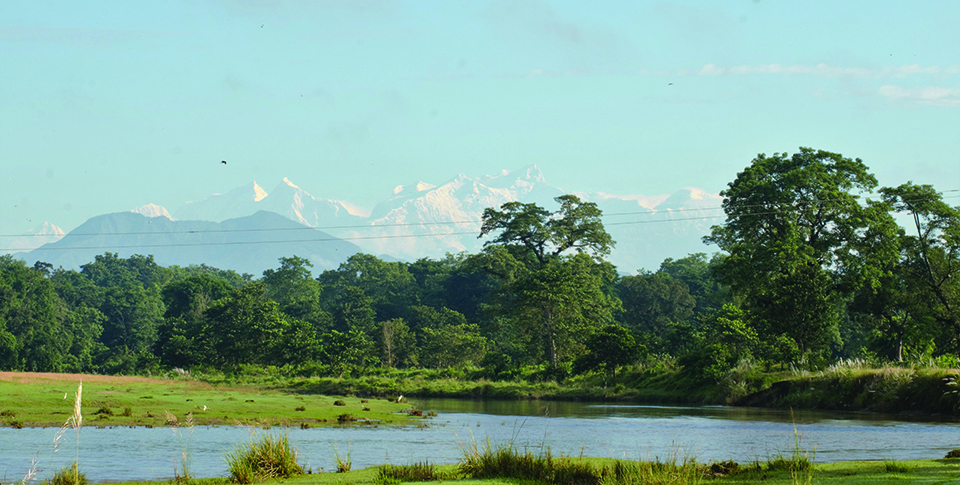
OR
Future of forests in federalism
Published On: August 11, 2018 01:00 AM NPT By: Ganesh Paudel and Prabin Bhusal


Ganesh Paudel and Prabin Bhusal
Paudel is Assistant Planning Officer at Department of Forests, Bhusal is Assistant Professor at Institute of Forestry, Pokharanews@myrepublica.com
More from Author
We should follow ‘devolve but don’t dissolve’ principle while formulating community forestry policies in federal Nepal
In his famous book Losing Ground: Environmental Stress and World Food Prospects Erik P Eckhlom in 1976 put forth ‘Theory of Himalayan Environmental Degradation’ describing the gloomy scenario of mountain environment. This predicted alarming situation of the environmental degradation at the mountain region. World Bank in 1979 predicted that Nepal will lose all its accessible forests by 2000 if degradation continues. Likewise, Asian Development Bank in 1982 predicted that all accessible forests in the hills will vanish within 20 years. Environmentalists at that time were worried and exploring the best way for reversing the mountain environment degradation.
Hard efforts of the communities have proved wrong these predictions in Nepal. Nepal has set the example for the world by involving communities in the forest management. The communities have turned the denuded hills into the green forests. Recognizing this, Nepal government in 2016 declared Shrawan 25 as the community forestry day marking the establishment of the first community forest in Thokarpa village of Sindhupalchok district 45 years ago.
The latest forest resource assessment report shows that forest area has increased from 29 percent in 1994 to 40.36 percent in 2014. There could be various reasons behind this, but mainly it is the outcome of rapid expansion of community forests in the mid-hills through enactment of Forest Act (1993) and Forest Regulation (1995). Based on the principles of common property regime developed by the Noble Laurate Elinor Ostrom (1990), Nepal’s community forests set the good example of the collective action for managing the common pool resources. As Nepal is pioneer in community forestry, International Community Forestry Research Center is going to be established here.
At present, 22,266 community forests are managing about 2.2 million hectares of the forest land. They are generating significant income and multiple benefits at local level. Similarly, the collective effort in management of commons has been instrumental to fight the increasing threat of climate change, natural disasters and famines. The initial goal of community forestry was to reverse the existing rate of deforestation and meet the basic forest product need of the local people. But in course of time, it has not only become limited to forest development and fulfillment of forest product need of local people, but also played important role in public infrastructural development for health and education. Recent studies show it has also contributed to achieving the sustainable development goals (SDGs).
The article published in the Forests journal (2018) and Community Forestry Bulletin (2017/18) has recognized the fact that community-based forestry has direct and indirect contribution to achieving the 13 goals of SDGs. Community forest user groups are successful and effective grass roots institutions. Any attempt to dismantle them should be discouraged.
Federalism and forestry
As the country has implemented federal governance, there is a fear that functioning of community forests could be disrupted. In some places, local levels are taking steps for controlling the community forests.
As per the provisions of the new constitution, seven provincial and 753 local governments have been formed and they have been granted several rights and powers. Likewise, forest polices are being drafted in line with the new constitution. Community forestry at this time is at the crossroads. Pressing questions at the moment are: How will these collective actions in management of commons will be strengthened? Will it create conflict with the local government? Will it be managing its income and resources like in the past? Will the local government hold the power to mobilize the community forests?
Many times, we have ignored the lessons of the past and decided based on superficial analysis of the present. We now have fast growing lush green forest and plenty of timber and other forest resources. We should not forget that this is the result of community forestry program and only community can better manage our forests in the future.
The constitution has defined the rights and powers of federal, provincial and local governments. Federal government has the right to develop the national forest policies, but is not directly involved in forest management in the field. The responsibility of managing national forests within the boundary of the state lies with the state government. As community forest is also a part of national forests its management right lies with the provincial government. Local level has the right of biodiversity and environmental conservation which is directly or indirectly related with the community forest.
Don Gilmour in his book Forty Years of Community Based Forestry has identified secure tenure (property rights), enabling regulatory framework, strong governance, viable technology, adequate market knowledge and supportive bureaucracy as keys to effective community-based forestry. These offer the guidelines to formulating community forestry policies in federal Nepal.
Local Government Operation Act (2017) includes environment and biodiversity conservation as one of the functions of local governments. Intergovernmental Fiscal Management Act (2017) outlines sharing of benefits obtained from the forest management in the three different tiers of the government.
Forest, which is the key natural resource, could become the source of conflict among different levels of government, particularly regarding access and control of forest resources. Thus we need to at least ensure that such conflicts do not undermine the autonomy of community forest user groups. Our four decades long experience has proved that the forest conservation and management through community is the most effective and efficient approach. Any attempt to undermine community rights will result in undesired outcomes thereby undermining sustainable forest management.
Saving forests
The contemporary literature shows community forests are facing pressures worldwide. Community forestry experts have outlined various threats including the reapportion of forest resources by governments. The issue of tax collection from local government is being raised in various forums. Taxation in community forests in blanket approach could be counterproductive. We should be clear that the community forests are not profit making organizations. They are social organizations promoting democracy, inclusion and social justice.
The forest act and regulation did not envision relationship between community forestry and local bodies. We need to establish economic and development linkage with local levels. The relationship between different layers of government and user groups should be based on principle of co-existence, cooperation and collaboration as envisioned by the constitution. We should follow ‘devolve but don’t dissolve’ principle while formulating community forestry policies in federal Nepal. Autonomy and rights of community forests shouldn’t be compromised.
Paudel is Assistant Planning Officer at Department of Forests, Bhusal is Assistant Professor at Institute of Forestry, Pokhara
ecopaudel@gmail.com
bhusalp1@gmail.com
You May Like This

Why Federalism has Become Risky for Nepalese Democracy
The question arises, do federal or unitary systems promote better social, political and economic outcomes? Within three broad policy areas—political... Read More...

Nepal's Forests in Flames: Echoes of Urgency and Hopeful Solutions
With the onset of the dry season, Nepal's forests undergo a transition from carbon sinks to carbon sources, emitting significant... Read More...

'Victim blaming'- Nepali society's response to sexual violence
Multiple studies show that in most sexual assaults, the attacker is someone known and trusted by the victim. ... Read More...




Just In
- MoHP cautions docs working in govt hospitals not to work in private ones
- Over 400,000 tourists visited Mustang by road last year
- 19 hydropower projects to be showcased at investment summit
- Global oil and gold prices surge as Israel retaliates against Iran
- Sajha Yatayat cancels CEO appointment process for lack of candidates
- Govt padlocks Nepal Scouts’ property illegally occupied by NC lawmaker Deepak Khadka
- FWEAN meets with President Paudel to solicit support for women entrepreneurship
- Koshi provincial assembly passes resolution motion calling for special session by majority votes







_20220508065243.jpg)






Leave A Comment